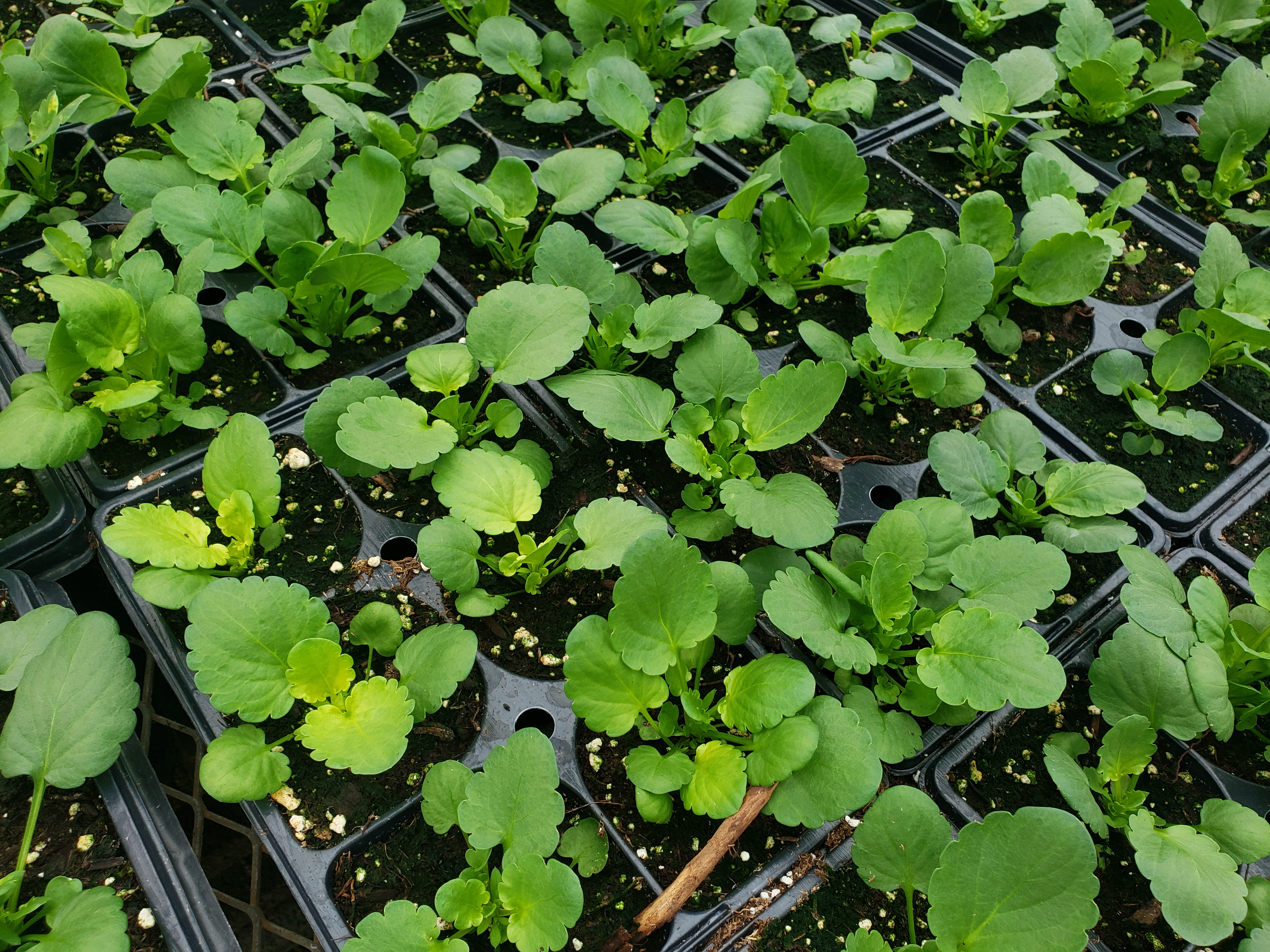Ammonium toxicity can cause chlorosis in pansies and other crops
Preventing and correcting ammonium toxicity in greenhouses: Understanding the causes, symptoms and solutions.

This spring, Michigan State University Extension received several reports from greenhouses of chlorosis in their pansy crops. Given that pansies are generally considered to require low fertility of 100 to 150 ppm nitrogen and a pH and EC range (PourThru) from 5.5 to 5.8 and 1.3 to 2.0 mS/cm, respectively, we did not believe it was a nitrogen deficiency as the grower was providing 115 ppm nitrogen at every irrigation. As pansies can develop both low and high substrate pH disorders, our first thought was that the substrate pH might be high given that pansies can develop interveinal chlorosis when the substrate pH is above 6.2 as iron becomes unavailable.
After a pH and EC test, we determined that the pH and EC were 6.0 and 1.98 mS/cm, respectively, which are not too far outside of the recommended ranges. We collected tissue samples from newly expanded leaves, triple rinsed with distilled water and submitted to a lab to analyze nutrient levels. The analysis indicated that nitrogen was 7.3%, which is above the recommended range for pansy (2.5 to 4.5%) and iron was 103 ppm, which is within the recommended range of 60 to 300 ppm for pansy.
The next step was to ask the grower what type of fertilizer they were using, as 115 ppm nitrogen (N) at every irrigation should not lead to such high N concentrations in the tissue. The grower indicated that they were utilizing a 20-10-20 fertilizer, which contains a high percentage of ammoniacal nitrogen.
Ammonium toxicity occurs when too much ammonium is available in the substrate, and plants take it up excessively. Water-soluble fertilizers may contain more than one form of nitrogen such as nitrate (NO3–), ammonium (NH4+) and urea [CO(NH2)2]. Ammonium and urea (urea converts to ammonium [NH4+]) can result in ammonium toxicity during the winter and early spring when light levels and temperatures are low, and substrates are saturated, oxygen deprived and between 55 to 65 degrees Fahrenheit. In the case of this pansy crop, the pH and EC were relatively in normal ranges but the surplus of nitrogen available as ammonium is what caused the toxicity symptoms.
During the early production season, bacteria that usually help convert ammonium to nitrate are not as active in cold substrates, which can lead to ammonium toxicity. While plant cells can store high levels of nitrate nitrogen without any harm, accumulating ammonium can damage cells. Therefore, acidic fertilizers such as 20-10-20 containing a high percentage of ammoniacal nitrogen should be avoided during cold and cloudy weather, especially in northern latitudes. Instead, nitrate-based fertilizers such as 15-0-15 should be used from November to March.
Fertilizers that are high in nitrate nitrogen and low in ammoniacal nitrogen are sometimes known within the industry as dark weather feeds. Additionally, ensure that plants are receiving adequate amounts of potassium, as it helps convert NH4+ to proteins, which lowers the foliar ammonium levels. Certain crops such as coleus, eggplant, lettuce, pansy, pepper, salvia, tomato and zinnia are especially sensitive to too much ammonium.
To avoid ammonium toxicity, monitor the ammonium levels and use fertilizers with a balanced ratio of ammonium and nitrate. Adjust the pH of the substrate to help convert ammonium to nitrate and use soil amendments to reduce ammonium levels. Following these steps can prevent ammonium toxicity and promote healthy plant growth.
Visual symptoms of ammonium toxicity begin as interveinal or marginal leaf chlorosis, chlorotic blotches or pale lime green foliage that mimic an iron deficiency. In mature plants, either upward or downward curling of leaf margins and even the floral buds can occur. Roots may also be affected with fewer roots forming and tips becoming necrotic with an orange-brown color. As the toxicity progresses, necrosis follows chlorosis on older leaves. Seed germination and establishment can be delayed as young leaves are more susceptible to ammonium toxicity and typically develop interveinal chlorosis. Similar to older plants, the margins of leaves will curl up or down depending on the species.

Correcting ammonium toxicity
- Increase substrate temperature by raising the air temperature or moving the crop to a heated bench or floor.
- Switch to a fertilizer with no ammoniacal nitrogen or a calcium-magnesium fertilizer.
- Leach the substrate with clear water, but make sure to allow it to dry down between irrigations.
To facilitate leaching in severe cases of ammonium toxicity, apply gypsum. Cornell University recommends applying 1 tablespoon of gypsum top-dressed to a 6-inch pot and irrigating with clear water. Follow up two hours later with 50 ppm of calcium nitrate. For more details, check out the article “Ammonium Toxicity: Avoid Getting Burned This Winter” by Neil Mattson.
Preventing ammonium toxicity
Preventing ammonium toxicity is crucial during the early spring when light levels and temperatures are low. Take active steps to prevent ammonium toxicity in sensitive crops from November to late March. One effective way to prevent ammonium toxicity is to use fertilizers with combined ammonium and urea, making up less than 40% of the total nitrogen. However, in extremely cold and cloudy conditions, this percentage should be further reduced to avoid toxicity.
Here are some steps to take to prevent ammonium toxicity in future seasons:
- Keep substrate pH at the higher end of the crop recommendations by monitoring regularly and taking steps to adjust as needed.
- Maintain greenhouse temperatures above 60 F (15 degrees Celsius).
- Do not allow nitrogen to build up in the substrate by over-fertilizing.
- Avoid keeping the substrate too wet.



 Print
Print Email
Email

